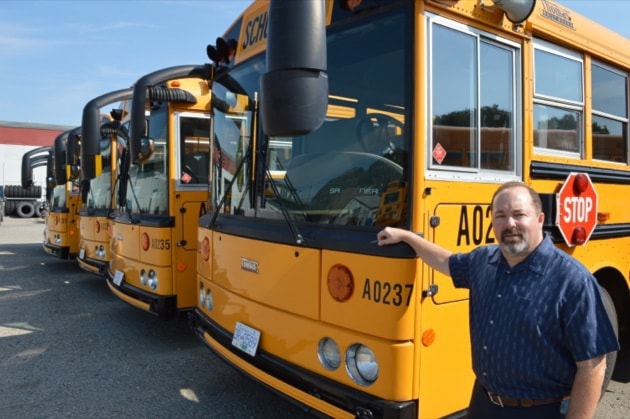They are ready to roll.
A fleet of 75 school buses sits ready in the Central Okanagan School District operations yard in Rutland. The routes have been tweaked, the buses have been checked over and come Tuesday morning, drivers will head out on 65 different routes across the Central Okanagan, transporting close to 6,000 students to school and picking them up again.
"It's exciting," said David Misener, the Central Okanagan School District transportation manager. "The two weeks leading up to the start of school is very hectic and busy, but we have been doing it as a group for a number of years so we have a good handle on opening week."
Misener is in charge of all things transportation in Central Okanagan, and while there are changes in what families may or may not have to pay when it comes to busing costs (see story, page __), Misener and his crew of 95 staff members, including drivers, mechanics and office staff, are only concerned with picking up and dropping off students safely and in a timely fashion.
"We're transporting more students to school every day than there are students in some school districts in the province," he said. "It's a big operation, one of the biggest in the province. We're larger than city transit and we're able to go into some places they can't. At year-end we are processing 6,000 students. On an average day there would be about 5,500 because not everyone rides the bus every day."
Before heading out on their route each school morning, drivers must do a complete inspection of the bus. They then head out on their route, picking up an average of 50 to 80 students per bus, depending on the size of the vehicle.
Their main concern is student safety. If the bus can stop completely off the road, the driver may opt to not engage the stop sign and flashing red lights that tells other drivers to stop and let kids cross the road. If there is any safety question, the stop sign and lights will be on and drivers are reminded to stop behind a school bus with flashing red lights.
It's a demanding job with energetic students heading to school and home from school each day.
"It's very demanding," agreed Misener, who joined the school district in 2007 after a career in the Canadian armed forces. "You might have up to 80 students on board and you have to follow all the rules of the road, hitting your stops. We try to design the routes so that students don't have to cross the road. We're talking to parents, principals, vice-principals and the school board all the time. I believe we are pretty flexible. If we see a need somewhere we make changes."
Of the school district's 75-strong bus fleet, about one-third are powered by compressed natural gas fuel while the rest are diesel-powered with one special needs bus being run on propane. All of the buses are approved to go on the road, however 10 or so remain on stand-by when the buses roll each morning. Each of them has a life-span of about 12 to 15 years or between 325,000 and 400,000 kilometres before they are taken out of service and can be used for spare parts or sold.
